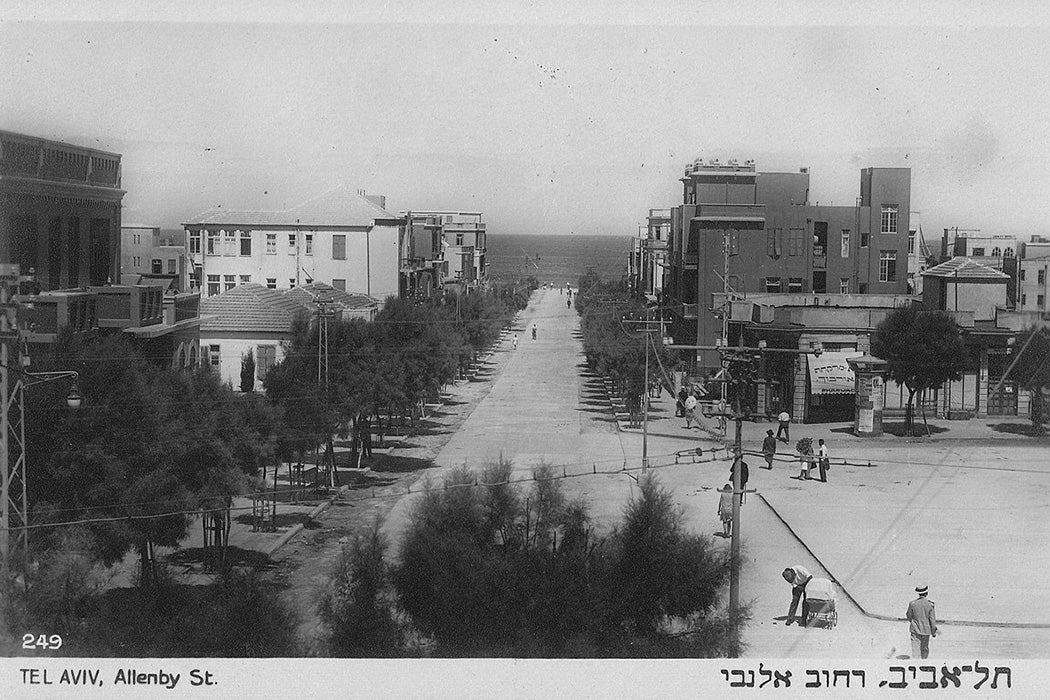The electrical illumination of Allenby Street in Tel Aviv in the summer of 1923 inaugurated the first electrical distribution system in what was then Mandate Palestine. Jewish residents were thrilled, but Palestinian Arabs in neighboring Jaffa protested that the new lamp posts were the “gallows of our nation.” Fredrik Meiton, a historian of the modern Middle East, shines a light on the Arab-Israeli conflict through the medium of electricity, placing this moment a century ago in the context of continuing debates over the supposed political neutrality and inevitability of technological adaptation.
Things began with Russian-born engineer Pinhas Rutenberg, who was known for his work in irrigation and bridge building in Italy. When he applied to British authorities in 1920 for an exclusive concession to electrify all Palestine, they were intrigued. Infrastructure-building was colonial policy and European Jewish immigrants to Palestine, considered “white but not quite,” were deemed to be suitable agents of such development in the context of darker-skinned “natives.”
Rutenberg envisioned fourteen hydroelectric power stations in and around the Jordan Valley. As he stressed in writing to fellow Zionists, his grand plan was unquestionably an aspect of Zionist colonialism and nation-building. Palestinian Arabs and Christians recognized this bias, so many opposed his plans.
Under the League of Nations mandate, the British had two agendas in Palestine: to support the development of a “Jewish national home” and to safeguard the rights of the non-Jewish in the region. (These contradictory mandates would haunt them until they retreated in defeat in 1948.) So Rutenberg ended up only getting approval for his more modest optional proposal, a single hydropower facility on the ‘Auja (Yarkon, in Hebrew) River. His own experts and others concluded the ‘Auja wouldn’t provide enough power for the heavily populated cities of Tel Aviv and Jaffa and potential industrial users. No matter: Rutenberg saw it as a foot in the door to the larger Jordan Valley development, a fact on the ground that couldn’t be denied.

“The ‘Auja scheme was a cat’s paw, primarily designed not to bring electricity to Jaffa, but to furnish Rutenberg with a claim to a countrywide energy monopoly on the strength of technological exigency,” writes Meiton.
Even though Rutenberg and the British recognized a sole-concession electrical grid as an avowedly Zionist nation-building project, they tried to it sell on “strict business lines.” They argued that the application of science and technology was a “natural” outcome of free market forces and that “money talks”: once the electricity started flowing, Palestinian opposition would melt away.
What Meiton describes as boundary-work, the “pursuit of political ends by non-political means,” constructing and policing a boundary between technology and politics, was in full force. Rutenberg, upfront about the importance of electrification to a Jewish homeland with other Zionists, tried to paint his opponents as the ones who were political, as well as irrational and anti-science/technology/progress.
And, along with his British allies, Rutenberg was largely successful. Initial Arab opposition was splintered by the defection of the municipal authorities in the city of Tiberias, who seem to have been aided by bribes. By then, the plan had changed yet again: instead of hydropower generation on the ‘Auja, electricity was generated by burning fossil fuel in Tel Aviv. The irrigation rights Rutenberg had managed to get in the ‘Auja Valley ended up only benefiting Jewish settlers. By the end of 1925, Tel Aviv, Jaffa, Haifa, and Tiberias were interconnected in Rutenberg’s electrical grid.
In the words of one colonial official, Ruetnberg wasn’t “out to make money so much as to make the Zionist policy a success.”
Meiton epxlains that “Palestinians’ eventual failure to maintain a united front against electrification facilitated the thickening of the grid. That, in turn, reduced its vulnerable to sabotage and changed the conditions for oppositional politics.”
Weekly Newsletter
Palestinians unquestionably wanted electricity. Arab merchants looked forward to it and ‘Auja farmers were intrigued by the associated promise (never delivered) of irrigation. But they wanted it on their own terms. Yet efforts by municipalities to get concessions to generate their own power were denied by the Mandate authorities, who supported the “dynamic” immigrants over the “backward” natives.
Bluntly put, Palestinians lost “the competition to define the boundaries of electrification,” as they would lose the competition to define the boundaries of Palestine/Israel.
Support JSTOR Daily! Join our new membership program on Patreon today.







